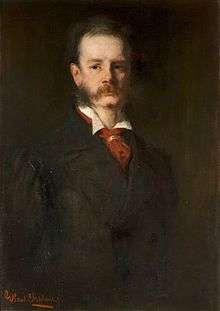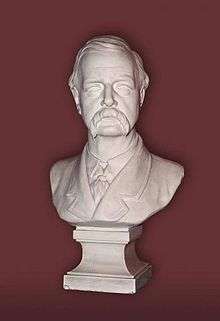John Batty Tuke
| John Batty Tuke | |
|---|---|
 | |
| Born |
9 January 1835 Beverley, England |
| Died |
13 October 1913 (aged 78) Edinburgh, Scotland |
| Residence | Scotland |
| Nationality | British |
| Fields | Neuroscience |
| Alma mater | University of Edinburgh |
| Known for | puerpural insanity, MP, President of the Royal College of Physicians of Edinburgh |
| Notable awards | Honorary D.Sc. Trinity College, Dublin, Knighthood |
Sir John Batty Tuke (9 January 1835 – 13 October 1913) was one of the most influential psychiatrists in Scotland in the late nineteenth century, and a Conservative Member of Parliament (MP) from 1900 to 1910.[1][2][3] Tuke’s career in Edinburgh from 1863 to 1910 spanned a period of significant social and political changes in asylum governance and care in Scotland.[4] Tuke’s professional success in public and private practice and his powerful role in several prominent medical societies allowed him to influence his colleagues toward a more physiological understanding of mental illness and its treatment.
Biography
Batty Tuke (as he is most often referenced) was born in Beverley, England in 1835.[5] Although the details of his father’s heritage are not known, articles about Batty Tuke link him to the famous Tuke family that founded the York Retreat.[6] In 1845 Tuke was sent to Edinburgh where he began attending the newly opened Edinburgh Academy. He graduated with honours in history and reading in 1851.[7] Tuke went on study at the Edinburgh University Medical School where he graduated in 1856 and was registered at the Royal College of Surgeons of Edinburgh.[8] Shortly after qualifying Tuke went to New Zealand as a medical surgeon for seven years in the Maori War.[5]
Upon his return to Edinburgh in 1863 Tuke was appointed to the Royal Edinburgh Asylum (later renamed the Royal Edinburgh Hospital) as an assistant physician.[5] Under the tutelage of the then superintendent David Skae Tuke quickly developed a niche in puerperal insanity and published influential articles on the subject.[9] In 1865 Tuke's reputation was confirmed with an appointment to the newly built Fife & Kinross District Asylum (now Stratheden Hospital) as superintendent.[5] There he had the ability to hire and train his entire staff and set out an "open-doors" model of care for his patients which gained him further accolades from his peers.[10] While Tuke was working in this influential position, his publications began especially to promote his ideas for the advancement of humane patient treatment.[11]
As his career progressed Tuke also occupied positions of leadership within the Royal College of Physicians of Edinburgh and wrote an influential article on the "cottage system" of care for insane people where he criticised the traditional Scottish practices of caring for "incurable" insane people by boarding them out with often destitute members of the community in exchange for meager compensation.[12] In 1873 Tuke returned to Edinburgh to take a joint management position with Dr Smith and Dr Lowe at the private Saughton Hall Asylum.[13] This move marked a change from public to private care and Tuke also set up a practice in Charlotte Square as a “specialist in mental diseases.” [5] That year, he was appointed to be Morison Lecturer at the RCPE for 1874,[14] and began teaching at the University of Edinburgh.[15] Another notable achievement during this time was his contribution to the ninth edition of the Encyclopaedia Britannica. Considered to be the most 'scholarly' edition produced by this publisher Tuke wrote the entries on hysteria and insanity.[16] Tuke also contributed to a series of “Health Lectures for the People” delivered in Edinburgh during the winter of 1881–2. His lectures on “The Brain and its Functions” debunked the science of phrenology and used visual demonstrations to teach the public about the brain.[17]

In 1894 Tuke was again appointed to the Morison Lectureship at the RCPE and chose “The Insanity of Over-exertion of the Brain” as his topic. This series would be the culmination of Tuke’s theory of physical disease as the cause of mental illness.[18] Tuke proposed that both the public and profession had been hampered by Hippocratic classifications of insanity that were entirely psychological and led to an ignorance of brain anatomy, physiology and pathology, and a focus on behavioural symptoms. He condemned the popular notion the public needed protection from lunatics as well as the idea that insanity was manifested through perversion of the intellect. According to Tuke these elements had combined to create communities and medical terminology that regarded insanity as “a disease of the mind.”
Tuke directly avoided the task of trying to explain “the dynamics of delusion” and focused on his theory of cell overexertion by injury, parasitism, deficient cell functioning or defective cell growth.[19] By focusing on cell functioning and cure through rest and nutrition, Tuke rejected attributions of moral infirmity or deficiency in the insane. Tuke saw these ideas as slowing the progress of treatment and scientific understanding since they “construct a psychological nexus between cause and symptom without demonstration of structural change in cortical tissues.” Tuke heralded the study of mental illness through brain anatomy as the way to “a rational system of treatment”and enjoined his colleagues to consider their patients “first as invalids and as an insane person after.”
Aside from the immediate exposure of the lecture hall Tuke’s talks were published in London and Edinburgh as well as in the Journal of Mental Science.[20] He was noticed and respected by his contemporaries and a few years later received his first honorary degree (D. Sc.) from Trinity College, Dublin where he was praised for having made "the first important step in the very obscure subject of the connection of the anatomy of the brain with mental derangement."[21]
In 1895 Tuke became president of the RCPE. In 1898 he was knighted[22] and later that year gave the “Address in Psychology” at the annual general meeting of the British Medical Association.[23] Tuke’s career as a psychiatrist ended with his election to parliament in 1900 as MP for Edinburgh and St Andrews Universities.[24] Once elected Tuke served in this role for ten years.
Tuke lived at 20 Charlotte Square a very fine and large Georgian townhouse in Edinburgh's First New Town.[25] Tuke died in Edinburgh on 13 October 1913.[26] His death was reported in several prominent medical journals and in The Scotsman newspaper.
He is buried in Warriston Cemetery in Edinburgh, on the north side of the central roundel, south of the central vaults.
Tuke received an LL.D. (honoris causa) from the University of Edinburgh in March 1902.[27]
Family
His daughter married Dr John Fraser FRSE (1844-1925) Commissioner of Lunacy in Scotland 1895-1910.[28]
References
- ↑ Nathalie Chernoff, "Sir John Batty Tuke and his influence on ideas about mental illness in late nineteenth century Edinburgh." Conference Presentation (Edinburgh: BPS History and Theory of Psychology Section Conference, 2009).http://www.bps.org.uk/downloadfile.cfm?file_uuid=AE1C854F-1143-DFD0-7E54-AB4D2A0A1717&ext=pdf
- ↑ “An admirable candidate” The Scotsman, 19 April 1900, p4.
- ↑ Craig, F. W. S. (1989) [1974]. British parliamentary election results 1885–1918 (2nd ed.). Chichester: Parliamentary Research Services. p. 571. ISBN 0-900178-27-2.
- ↑ Lorraine Walsh, “‘The Property of the Whole Community’, Charity and Insanity in Urban Scotland: The Dundee Royal Lunatic Asylum,” in Insanity, Institutions and Society, 1800–1914, ed. Joseph Melling and Bill Forsythe (London: Routledge, 1999), 180.
- 1 2 3 4 5 "Obituary: Sir John Batty Tuke,” The British Medical Journal (13 October 1913):1045.
- ↑ "Obituary: Sir John Batty Tuke,” The British Medical Journal (13 October 1913):1045.; “Saturday’s bulletin”, The Scotman, 23 April 1900, p6.
- ↑ "Graduation Records of the Edinburgh Royal Academy" (Edinburgh: Edinburgh Royal Academy, 1851)
- ↑ "Sir John Batty Tuke" in Registry of Faculty Alumni: Trail-Volume (Edinburgh Library Special Collections); “Licentiateship of Duncan Sinclair & John Batty Tuke” Royal College of Surgeons of Edinburgh Register (Edinburgh: RCSE Private Library, 1856).
- ↑ John Batty Tuke, "Cases illustrative of the insanity of pregnancy, puerperal mania, and insanity of lactation" The Edinburgh Medical Journal, 12 (1866):1083.
- ↑ National Health Service (NHS): Fife, "Records of Stratheden Hospital," http://www.fifedirect.org.uk/news/index.cfm?fuseaction=feature.display&objectid=A32FCED9-EAB4-FA3F-105EF079555353B5 ; G. A. Doody, A. Beveridge, E. C. Johnstone, “Poor and Mad: A Study of Patients Admitted to the Fife and Kinross District Asylum Between 1874 and 1899” Psychological Medicine, 26:5(1996): 887–898.
- ↑ John Batty Tuke, “Cases illustrative of the insanity of pregnancy, puerperal mania, and insanity of lactation” The Edinburgh Medical Journal, 12 (1866):1083; John Batty Tuke, “On a new lesion observed in the brain” Edinburgh Medical Journal, September (1868): 204 ; John Batty Tuke, Morbid appearances met with in the brain of thirty insane persons. (Edinburgh: Oliver & Boyd, 1869); John Batty Tuke, “The Cottage System of Management of Lunatics as Practiced in Scotland, with Suggestions for it Elaboration and Improvement,” The Journal of Mental Science, 15 (1870): 531–532.
- ↑ John Batty Tuke, "The Cottage System of Management of Lunatics as Practiced in Scotland, with Suggestions for it Elaboration and Improvement," The Journal of Mental Science, 15 (1870): 531–532.
- ↑ Joseph Jackson Howard and Frederick Arthur Crisp, Visitation of Ireland, (Baltimore: Genealogical Publishing, 1973), 30.
- ↑ “Morisonian Lectures on Insanity”, The Scotsman, 26 March 1874, p4.
- ↑ "Edinburgh School of Medicine" The Scotsman, 4 November 1873, 3.
- ↑ John Batty Tuke, "Hysteria" The Encyclopaedia Britannica (London: Encyclopaedia Britannica, 1875); John Batty Tuke, “Insanity” The Encyclopaedia Britannica (London: Encyclopaedia Britannica, 1875) & “Obituary: Sir John Batty Tuke,” The British Medical Journal (13 October 1913):1045.
- ↑ John Batty Tuke, “The Brain and its Functions” in Health Lectures for the People: Second Series (Edinburgh: Macniven & Wallace, 1882), 83 & 96.
- ↑ John Batty Tuke, The Insanity of Over-exertion of the Brain, (Edinburgh: Oliver and Boyd, 1894).
- ↑ John Batty Tuke, The Insanity of Over-exertion of the Brain, (Edinburgh: Oliver and Boyd, 1894) p17.
- ↑ John Batty Tuke, The Insanity of Over-exertion of the Brain. (Edinburgh: Oliver and Boyd, 1894)l; John Batty Tuke, The Insanity of Over-exertion of the Brain. (London: Simpkin, Marshall, Hamilton, Kent and Co., Ltd, 1894) & John Batty Tuke, “The Insanity of Over-exertion of the Brain,” Journal of Mental Science, 41(1895): 331–335.
- ↑ "Honours to Edinburgh Scientists" The Scotsman, 20 June 1896, 9.
- ↑ "Sir John Batty Tuke," The Royal Society of Edinburgh Medical Fellows Elected 1841–1882, Volume 4 ,(Edinburgh: Scotland’s Cultural Heritage, 1983).
- ↑ Sir John Batty Tuke, “Modern Conceptions of the Etiology of the Insanities,” British Medical Journal, (6 August 1898): 341–345.
- ↑ "Sir J.B. Tuke a member of parliament," The New York Times (4 May 1900).; "Obituary: Sir John Batty Tuke,” The British Medical Journal (13 October 1913):1045.
- ↑ Edinburgh and Leith Post Office Directory 1889-1890
- ↑ ”Obituary: Sir John Batty Tuke,” The British Medical Journal (13 October 1913):1045.
- ↑ "University intelligence". The Times (36711). London. 10 March 1902. p. 11.
- ↑ BIOGRAPHICAL INDEX OF FORMER FELLOWS OF THE ROYAL SOCIETY OF EDINBURGH 1783 – 2002 (PDF). The Royal Society of Edinburgh. July 2006. ISBN 0 902 198 84 X.
External links
 Works written by or about John Batty Tuke at Wikisource
Works written by or about John Batty Tuke at Wikisource- Hansard 1803–2005: contributions in Parliament by John Batty Tuke
| Parliament of the United Kingdom | ||
|---|---|---|
| Preceded by Sir William Overend Priestley |
Member of Parliament for 1900 – January 1910 |
Succeeded by Sir Robert Finlay |
| Academic offices | ||
|---|---|---|
| Preceded by William Tennant Gairdner |
President of the Royal College of Physicians of Edinburgh 1895–1898 |
Succeeded by James Andrew |